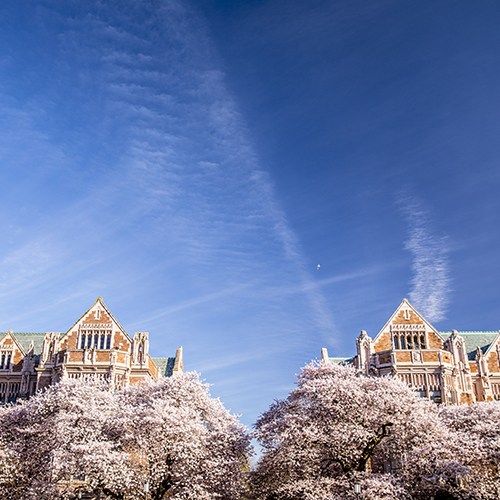When George Kennan trekked through the remote Caucasus Mountains in 1870, recording his observations in a series of journals, he could not have imagined that a young American woman would retrace his steps more than 120 years later.
But Frith Maier, an adventurer in her own right, seemed destined to make the journey.
Maier ’87, ‘98, was already an experienced mountain climber and adventure traveler when she headed to the Caucasus (in the former Soviet Union) in 1996. She spent two months travelling Kennan’s route, comparing her own observations with Kennan’s earlier writings. The project became Maier’s UW master’s thesis—“much longer than any master’s thesis has a right to be,” she jokes—and was published in January 2003 by University of Washington Press as Vagabond Life: The Caucasus Writings of George Kennan.

The project combined two of Maier’s passions: Russia and adventure travel. Maier began studying Russian as a UW undergraduate, taking an intensive course that left a lasting impression. “We never used a word of English,” she recalls. “It was so challenging that I cried the first two weeks of class.” Maier stuck with the course and later spent four months on a Russian fishing boat and a year studying in Leningrad before earning her B.A. in international studies from the UW. By then, she was hooked on everything Russian.
“I love the Russian language and the poetry, but it’s all about the people for me,” she says. “I’m still so inspired by Russian people. It’s not naïve romanticism. I’ve lived there a total of about four years (over the course of 40-some trips). When I go there, I feel like I’m home.”
It helps that Maier has made lasting friendships in the former Soviet Union. During her year as a student in Leningrad, she made many friends by joining the school’s climbing club. “I was a bit of a curiosity,” she admits, “but it was a great way to meet people.” (Maier has since summited several major peaks in the region and was the first non-Soviet Bloc woman to climb the nearly 23,000-foot Khan Tengri.)
Back in Seattle, Maier volunteered with the Tashkent Sister City Committee in the 1980s, leading a climbing trip to Tashkent and hosting a Tashkent climbing group in the Northwest. Later she developed a Russian and Central Asia Adventure Program for Recreational Equipment Inc. (REI), coordinating the program for nine years.
“I organized trip itineraries through the winter, then led five to seven expeditions over the summer,” says Maier, who published the book Trekking in Russia and Central Asia in 1994. She also planned independent trips, including a trek across Afghanistan that involved “crossing a couple of troubled borders” and led to a nine-day stay in a Tajik jail when she and her travel partner were suspected of spying.
Maier’s many trips to Central Asia piqued her interest in the region’s history, and she decided to return to the UW for graduate study. She enrolled in the Russian, East European, and Central
Asian Studies Program in the Jackson School of International Studies.
That’s when George Kennan’s Caucasus journey became her own. Maier was contacted by documentary filmmaker Chris Allingham, who had read her book on trekking and proposed
a trip to the Caucusus to follow George Kennan’s route.
“I had always harbored a fascination with Kennan,” says Maier. “He was one of the earliest paragons of adventure travel—even though there was no name for it then. He just wanted to throw a dart at the world, to go where it took him. His dart took him to Russia and it became a lifelong passion. It’s pretty much what happened to me, too.”

Maier and Allingham spent weeks at the Library of Congress in Washington, D.C., reviewing Kennan’s unpublished Caucasus journal. “Kennan was a very good, diligent observer,” says Maier. “He wrote about the people, the landscape, and the day-to-day challenges in people’s lives. The journal was close to 300 pages, handwritten in the tiniest pencil hand. My sister, Mihkel Kryman, transcribed the text using a magnifying glass—it’s too hard to read with the naked eye.”
When Kennan traveled in 1870, he had a lucky break: at the start of the trip, he befriended a Georgian prince who was traveling through the same region. “Kennan accompanied Prince Jorjadze (one of many Georgian princes) across the mountains, through villages and across
the Caucasus ridge as part of the Prince’s entourage,” says Maier. “Jorjadze was like his personal guide.”
Maier and Allingham headed to the Caucasus in Autumn 1996 with Kennan’s writings as their guide. They sought people with a connection to Kennan’s journey and found several. “In one
village, we stayed in the home of the naib (the local leader), who was a descendant of the naib Kennan had stayed with,” says Maier. “And we met the great, great grandchildren of Prince Jorjadze, who are wonderful people and quite renowned in Tbilisi. We pored over old photographs with them.”

Back in Seattle, Maier continued to be intrigued by the Caucasus experience. “I got caught up in it and went in deeper and deeper,” she says. “I went back to the Library of Congress to learn more.” That’s when she decided to make the project her master’s thesis.
Maier credits her advisor, Professor Dan Waugh, with transforming her thesis into a publishable book. Waugh showed the manuscript to Michael Duckworth at the University of Washington Press, who agreed that it was worthy of publication. The manuscript survived the peer review process and Duckworth told Maier it would be ready for publication “with a
few minor revisions” suggested by the reviewers.
For Maier, that was a good news/bad news situation. “In the meantime I’d had a baby and started a company and I was working 65 hours a week,” she recalls. “The revisions would have taken about one month—not long, really—but I didn’t have a month to focus on it.” Waugh, determined to see the book published, offered to do the work.
“Dan did all of it,” says a grateful Maier. “He addressed the history sections that needed more polish, he did the indexing. It’s a much better book thanks to his efforts. The way he takes his students’ work to heart is incredible. He’s a true teacher.”
Are other travel adventures in the works for Maier? Not just yet. With a young child at home, she’s mostly staying put these days. But in a few years… who knows.
“The beauty of travel is how it sparks an interest in what came before,” says Maier. “For me, travel is a starting off point for exploration of history. That’s why I became so caught up in the Kennan journals.”
More Stories

Demystifying Quantum
In a physics course for non-STEM majors, Professor Miguel Morales teaches quantum mechanics without the advanced mathematics most quantum courses require.

Can Machines Learn Morality?
UW researchers at the Institute for Learning & Brain Sciences and in the Allen School are exploring the potential for training AI to value altruism.

Meet Our 2025 Graduate Medalists
Meet the four graduating students selected by the College of Arts & Sciences as 2025 Graduate Medalists for their accomplishments.